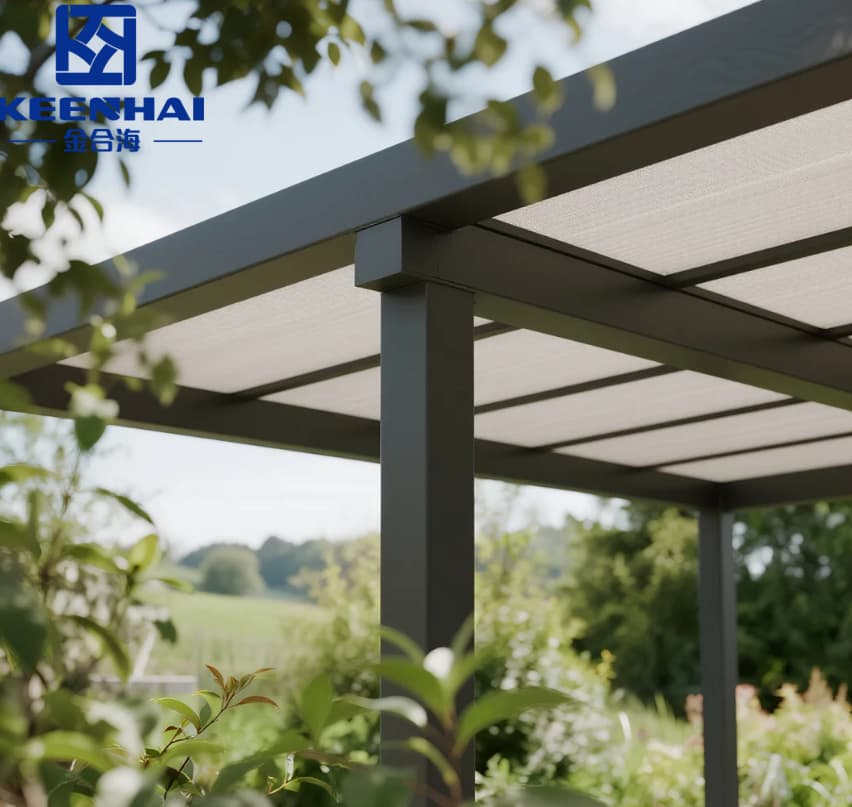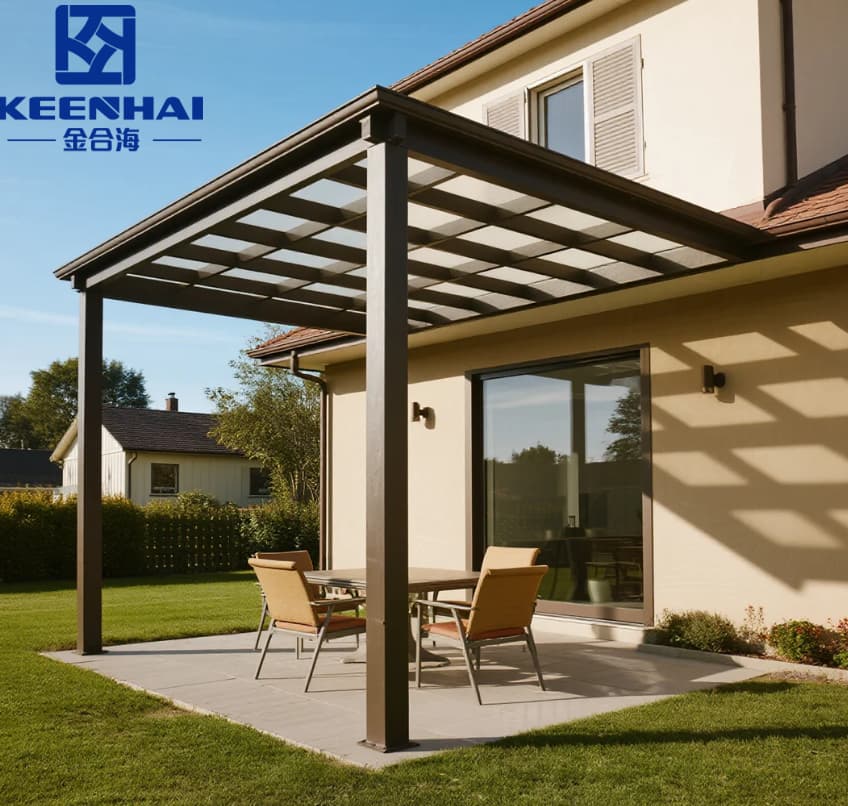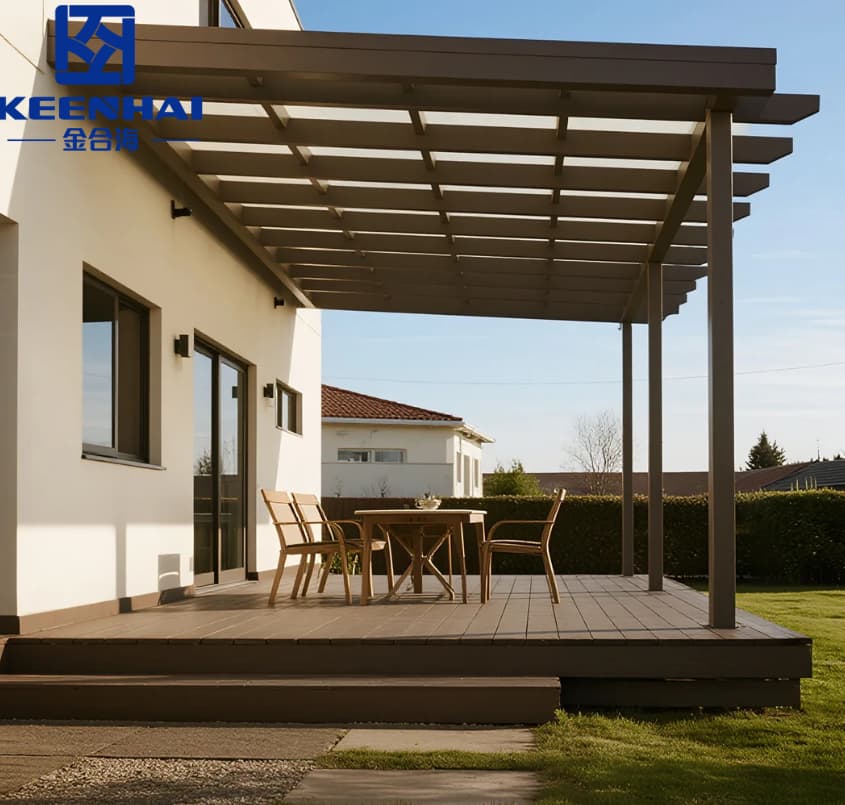
1. Cost Comparison Overview
When deciding whether to buy a pergola or build one yourself, understanding the complete cost picture is crucial. Many homeowners assume that DIY is always cheaper, but there are multiple factors to consider beyond the initial purchase price. Let’s break it down into clear steps and comparisons.
1.1 Average Cost of Buying a Prefabricated Pergola
Buying a prefabricated pergola can save time and ensure professional-quality construction. Prices for aluminum or wood pergolas vary widely depending on size, design, and included features. For instance:
-
Small to mid-sized aluminum pergolas typically range from $1,500 to $4,000.
-
Wooden pergolas, often custom-built or stained, can cost between $1,200 and $3,500.
-
Vinyl or composite options fall in the $1,800 to $3,000 range.
Prefabricated aluminum options, such as a prefabricated aluminum pergola, come with pre-drilled holes, adjustable louvers, and a durable powder-coated finish, reducing installation complexity. Homeowners save labor costs and reduce the risk of construction errors, making the slightly higher upfront price worthwhile. According to a construction cost guide from recent industry reports, the installation labor for prefabricated structures averages $500–$1,200, depending on local rates and site preparation needs.
1.2 Average Cost of Building a DIY Pergola
Building a pergola yourself might seem cheaper at first glance because you avoid professional labor fees. However, DIY costs can quickly add up depending on the materials, tools, and time investment:
-
Material Costs: High-quality wood (cedar or redwood) costs around $15–$30 per linear foot, while aluminum materials range $25–$45 per linear foot. Choosing long-lasting, weather-resistant materials is key to reducing long-term expenses.
-
Tools and Equipment: If you don’t own essential tools, renting or buying items such as drills, saws, levels, and concrete mixers can add $200–$600.
-
Time Investment: Completing a DIY pergola can take anywhere from 20 to 50 hours, depending on skill level and complexity. For many homeowners, this equates to the equivalent of $500–$1,000 in labor if outsourced.
Building your own pergola can also be rewarding because you can customize it exactly to your yard layout and design preferences. However, mistakes in measurements or leveling can increase costs, and long-term durability depends heavily on proper installation techniques. Consider using a modern aluminum gazebo as a reference for modular designs that simplify DIY assembly while maintaining a sleek, contemporary look.
1.3 Hidden Costs and Additional Expenses
Both buying and building come with hidden costs that often surprise homeowners:
-
Site Preparation: Clearing and leveling the ground, installing footings or concrete bases, and adjusting drainage can cost $300–$800 depending on soil conditions.
-
Permits: Local building codes may require permits for structures over a certain size. Permit fees typically range from $50–$250, varying by city.
-
Finishing and Accessories: Items like stain, sealant, or integrated lighting for DIY pergolas may add $100–$500. For prefabricated aluminum structures, optional accessories such as side panels, screens, or motorized louvers can increase cost by $200–$1,000.
When all these costs are added, a DIY wooden pergola that initially seemed cheaper can quickly approach—or even exceed—the price of a prefabricated aluminum pergola from keenhaipergola. This shows why evaluating total project costs, including hidden expenses, is essential for an accurate comparison.
1.4 Key Takeaways from Cost Analysis
-
Initial purchase price is not the whole story: Labor, tools, and time significantly affect total cost.
-
Material choice matters: Aluminum pergolas provide long-term savings through durability and low maintenance, while wood may require recurring sealing and pest control.
-
Site-specific factors: Sloped or uneven yards, extreme weather regions, or large designs may increase installation complexity and costs.
By considering these factors, homeowners can make an informed decision whether buying or building a pergola is truly cheaper for their specific situation. For those seeking low-maintenance, durable, and stylish options, prefabricated aluminum pergolas often provide the best balance between upfront investment and long-term value.

2. Material Choices and Their Impact on Cost
When you’re deciding whether to buy or build a pergola, the material you choose has a huge impact on the overall cost, longevity, and maintenance requirements. Different materials perform differently in weather, ease of installation, and long-term value, so it’s important to weigh your options carefully. Let’s break it down.
2.1 Aluminum Pergola Costs vs Wooden Pergola Costs
-
Aluminum Pergolas: Prefabricated aluminum pergolas typically range between $1,500 and $4,000, depending on size, finish, and whether you choose adjustable louvers or built-in screens. Aluminum is lightweight, rust-resistant, and requires almost no maintenance, which makes it very cost-effective in the long run. For example, a prefabricated aluminum pergola can last 20–30 years without major repairs, saving hundreds in upkeep compared to wood.
-
Wooden Pergolas: High-quality cedar or redwood structures usually cost $1,200–$3,500. While wood is naturally beautiful and customizable, it demands frequent sealing, staining, or pest treatments. Over a 10–15 year period, maintenance can add $500–$1,000, which should be factored into the DIY pergola cost comparison.
By comparing these two, it’s clear that while wood may have a lower initial price, an aluminum pergola often becomes cheaper over time due to low maintenance requirements. This is why many homeowners searching for “aluminum pergola vs wood pergola cost” decide to invest upfront in aluminum.
2.2 Vinyl and Composite Pergolas: Price vs Durability
-
Vinyl Pergolas: These are generally sold in kits priced $1,800–$3,000. Vinyl is resistant to rot, insects, and fading, but it can warp or crack in extremely cold or hot climates. DIY vinyl pergolas are popular because installation is often simpler than wood, but careful handling is required to avoid damage.
-
Composite Pergolas: Made from wood-plastic blends, composite pergolas cost $2,000–$4,000. They mimic the look of real wood without as much upkeep. Still, composite materials are heavier, sometimes requiring additional supports and slightly more complex installation.
When considering long-term cost and durability, vinyl and composite options fall between wood and aluminum. For homeowners prioritizing low maintenance and high durability, an aluminum pergola or modern aluminum gazebo is usually the preferred choice.
| Material | Average Cost | Lifespan | Maintenance |
|---|---|---|---|
| Aluminum | $1,500–$4,000 | 20–30 years | Minimal |
| Cedar/Redwood | $1,200–$3,500 | 10–15 years | Staining, sealing, pest control |
| Vinyl | $1,800–$3,000 | 15–20 years | Cleaning, avoid cracks |
| Composite | $2,000–$4,000 | 15–25 years | Occasional cleaning |
2.3 Cost Implications of Different Sizes and Designs
-
Size: Pergola costs increase significantly with size. Small 10×10 ft pergolas are usually cheaper than 12×16 ft or larger models. Aluminum pergolas scale more efficiently because prefabricated panels reduce labor costs, while wood costs rise almost linearly with size.
-
Design Complexity: Features like adjustable louvers, side screens, built-in planters, or lighting increase the price. A modern aluminum gazebo or aluminum pergola house with integrated louvers may add $500–$1,500 to the base price but improves usability and long-term value.
-
Customization: Custom shapes or irregular layouts require more planning and materials. DIY builders may spend extra on tools and modifications, whereas prefabricated aluminum pergolas come ready-to-install, saving time and reducing mistakes.
Overall, when comparing costs, size and design features are as important as material choice. Aluminum pergolas offer predictable pricing, long-term durability, and low maintenance, which often outweigh initial savings from wood or vinyl for DIY projects.

3. Labor and Installation Considerations
When planning your pergola project, labor and installation are as important as material costs. Choosing between hiring professionals or doing it yourself impacts your budget, timeline, and even the pergola’s durability. Let’s dive into the details.
3.1 Hiring Professionals vs DIY Installation
-
Hiring Professionals: Opting for professional installation ensures the structure is stable, leveled, and meets local building codes. Labor costs typically range from $500–$1,200 for small to mid-sized pergolas, depending on complexity and location. Professionals also handle site preparation, anchoring posts, and adjusting louvers if you choose a prefabricated aluminum pergola like this one.
-
DIY Installation: Doing it yourself saves on labor fees but requires time, skill, and proper tools. A DIY project can take 20–50 hours, depending on experience and pergola complexity. Mistakes in leveling or attaching crossbars can increase material waste and reduce structural longevity. A modern aluminum gazebo kit is ideal for DIY because it comes pre-drilled and modular, simplifying assembly.
| Factor | Hiring Professionals | DIY Installation |
|---|---|---|
| Labor Cost | $500–$1,200 | $0 (but consider value of your time) |
| Time Required | 1–3 days | 20–50 hours depending on skill |
| Skill Level | Low (professionals handle work) | Medium to High (requires accurate measurements and assembly) |
| Risk of Mistakes | Minimal | Higher, especially for first-time builders |
| Tools Needed | Mostly provided by contractor | Drill, level, saw, concrete mixer, etc. |
| Adjustability & Customization | Professional advice available | Fully customizable if confident |
This table shows that professional installation reduces stress and risk but comes at a price, while DIY installation is cheaper upfront but demands more effort and skill. For a high-quality aluminum pergola house or large custom pergola, professional help often pays off.
3.2 Time Investment and Skill Requirements
-
Professional Installation Timeline: Professionals usually complete small to mid-sized pergolas in 1–3 days. They coordinate site preparation, install footings, erect posts, and attach beams and crossbars efficiently. For complex designs like adjustable louvered bioclimatic pergolas, they ensure smooth operation and structural stability.
-
DIY Time Considerations: A first-time DIYer should expect 20–50 hours depending on pergola size and complexity. Each step—from measuring, leveling, post installation, to attaching rafters—requires accuracy. Mistakes in early steps can delay completion and increase costs for materials or repairs.
-
Skill Requirements: Installing a pergola isn’t overly complicated, but it requires basic carpentry or metalwork skills. Accuracy in measuring, drilling, and leveling is essential. Prefabricated aluminum pergolas reduce skill barriers since components are pre-cut and modular, making them beginner-friendly.
3.3 Tools and Equipment Costs for DIY Projects
-
Basic Tools Needed: For a DIY pergola, you typically need a drill, saw, level, measuring tape, screwdrivers, and safety gear. Renting specialty tools like a concrete mixer or post-hole digger can cost $50–$200 for the project duration.
-
Optional Tools for Efficiency: Laser levels, torque drills, and clamps can speed up the process and improve accuracy. Investing $100–$300 in these tools can prevent errors, especially for larger aluminum or wood pergolas.
-
Cost Implications: While tools add upfront expense, they are reusable for future projects. Homeowners building multiple DIY pergolas or other outdoor structures may find these investments worthwhile.

4. Maintenance and Longevity Considerations
Proper maintenance and understanding the longevity of your pergola is key to protecting your investment. Whether you choose aluminum, wood, or bioclimatic designs, knowing how materials respond over time helps you plan for upkeep and ensures your pergola stays beautiful for years.
4.1 Cleaning and Upkeep
-
Aluminum Pergolas: Aluminum pergolas are incredibly low maintenance. A simple monthly rinse with water and occasional mild soap cleaning prevents dirt buildup and keeps the finish vibrant. Avoid harsh chemicals that might damage powder coating. For larger setups like modern aluminum gazebo or aluminum pergola house, you can use a garden hose with a gentle spray to clean all corners efficiently.
-
Wood Pergolas: Wood requires more attention. Every 1–2 years, you should stain or seal your structure to prevent water damage, rot, or UV degradation. Inspect for cracks or warping regularly, particularly after heavy rains or extreme heat. Wooden pergolas are beautiful but demand consistent maintenance to keep their structural integrity.
-
Bioclimatic Pergolas: Adjustable louver systems in bioclimatic pergolas need occasional lubrication and cleaning of the louvers. Keep gutters or drainage channels clear to avoid water accumulation, which could affect the mechanism over time.
4.2 Resistance to Pests, Rot, and Rust
-
Aluminum Pergolas: Aluminum doesn’t rot or attract insects, making it ideal for areas with termites or high humidity. Its rust resistance also ensures long-term durability even in coastal environments.
-
Wood Pergolas: Wood is vulnerable to termites, carpenter ants, and mold if not properly treated. Regular inspections and treatment applications are necessary to maintain performance.
-
Vinyl or Composite Options: These materials resist pests and rot but can be susceptible to cracking in extreme temperatures. If your pergola includes stainless steel fasteners or decorative panels, you can visit pvdstainlesssteel.com to learn more about stainless steel products and project examples for added durability.
4.3 Expected Lifespan and Long-Term Value
-
Aluminum Pergolas: With minimal maintenance, aluminum pergolas can last 20–30 years. They maintain structural strength and aesthetic appeal with little intervention, making them cost-effective over time.
-
Wood Pergolas: Even with regular upkeep, wood typically lasts 10–15 years in outdoor conditions. Quality cedar or redwood can extend this, but ongoing staining, sealing, and pest control add labor and material costs.
-
Bioclimatic and Modern Pergolas: High-end bioclimatic pergolas or aluminum pergola houses with adjustable louvers can last 25–30 years. Their durability combined with low maintenance makes them a preferred choice for homeowners seeking long-term value. Regular checks of moving parts and occasional lubrication of louvers will ensure they function smoothly over decades.
